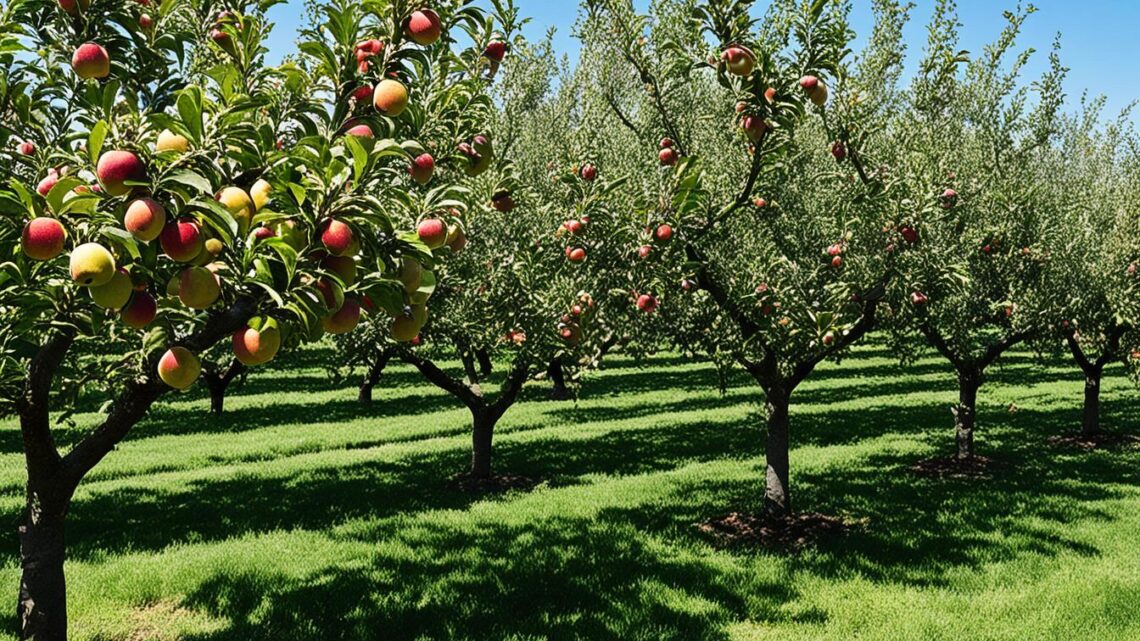
Do you dream of a fruit orchard that thrives and lasts? Consider disease-resistant fruit trees! They offer a way to grow your own food that’s both rewarding and sustainable. This guide will help you pick the best trees, prepare their home, and care for them to stay healthy and fight off diseases. You’ll learn how to create an orchard that gives you plenty of delicious fruit for many years.
Choosing the Right Disease-Resistant Fruit Tree Varieties
When picking fruit trees, choose ones made to fight off diseases and fit your area’s climate. Don’t go for common supermarket trees as they often get sick easily. Look for advice from local nurseries or extension services to find the best trees for your area.
Factors to Consider for Disease Resistance
Think about chill hours, pollination, and rootstock when picking trees. Pick trees that can handle common diseases and pests where you live. For example, ‘Liberty,’ ‘Enterprise,’ and ‘Freedom’ apples resist scab and fire blight. ‘Reliance’ peaches and ‘Methley’ plums are good against pests.
Popular Disease-Resistant Fruit Tree Cultivars
‘Harrow Delight’ and ‘Rescue’ pears are great choices for fighting diseases. ‘Reliance’ peaches and ‘Methley’ plums are also good against pests. Talking to local experts can help you pick the best trees for your garden and ensure a great organic gardening experience.
Choosing trees that fight diseases means you use fewer chemicals. This makes your garden more sustainable and eco-friendly. Whether it’s disease-resistant apple trees, scab-resistant apples, or pest-tolerant peaches, the right trees make your garden thrive.
Preparing the Planting Site for Healthy Growth
Getting your soil ready is key for your fruit trees to stay healthy and fight off diseases. Start by testing your soil to see its pH, nutrient levels, and how much organic matter it has. Then, add compost, lime, or other stuff if needed to make it perfect for fruit tree planting.
Make sure the soil drains well and is full of organic stuff. This helps your tree’s roots grow strong and keeps good soil microbes that fight diseases. Also, your planting spot needs good drainage and lots of sunlight. Fruit trees need soil that drains well to avoid root rot and other issues. They should get 6-8 hours of sunlight every day.
Soil Testing and Amendments
Good soil health is key for your fruit trees to do well. First, test your soil to check its pH, nutrient levels, and organic matter. Then, add compost, lime, or other stuff as needed to make it perfect for your trees.
- Check the soil’s pH and aim for 6.0-6.5 for most fruit trees.
- Add organic stuff like compost to make the soil better and hold water.
- Use lime or sulfur if needed to fix the soil’s pH.
- Put in slow-release organic fertilizers for steady nutrients.
Drainage and Sunlight Requirements
Good drainage and sunlight are key for your fruit tree planting. Fruit trees need soil that drains well to avoid waterlogged roots and diseases.
- Choose a spot that gets at least 6-8 hours of sunlight a day.
- Check the drainage by digging a 1-foot-deep hole and filling it with water. If it doesn’t drain in 12 hours, you might need to fix it.
- Add compost or other organic stuff to help with drainage and water.
- Think about using raised beds or berms if your spot drains poorly.
By getting your planting spot ready, you’re helping your disease-resistant fruit trees grow strong and give you lots of tasty fruit.
| Fruit | Calories (per 100g) | Vitamin C (mg) | Potassium (mg) |
|---|---|---|---|
| Apple | 52 | 4.4 | 107 |
| Pear | 57 | 4.0 | 116 |
| Peach | 39 | 6.6 | 190 |
Proper Planting Techniques for Disease-Resistant Fruit Trees
When planting your disease-resistant fruit trees, follow best practices for success. For bare-root trees, cut off the top third to help the plant grow strong roots. Container-grown trees should have their roots loosened before planting.
It’s key to plant your trees right for a good start. Dig holes big enough for the roots, but don’t plant the tree too deep. This can stop the roots from growing well.
- Apples on dwarfing rootstocks can have problems if planted too deep.
- For trees on clonal rootstocks, keep the union at least four inches above the soil.
- Planting trees shallow is better because it’s easier to fix later.
- Think about the union height to avoid scion rooting or borer problems.
- Too much rootstock above the soil can make trees weaker.
Adding compost to the hole helps trees grow strong roots and start well. Don’t give trees fertilizer when you plant them. Wait until May or June when they start growing.
| Fruit Tree Species | Nitrogen Requirement |
|---|---|
| Peaches and Nectarines | Highest |
| Pears | Second Highest |
| Apples, Apricots, Plums/Pluots, Cherries | Lowest |
Planting fruit trees in April is better than a month later. Late planting can cause trees to struggle. Fall planting is risky but can work for some trees like Tall Spindle apples in mid-November.
Pruning and Training for Optimal Tree Health
Proper fruit tree pruning keeps your trees healthy and productive. It stops diseases by cutting out damaged wood. Make sure to cut at the right angle, clean your tools, and prune when it’s dry.
Training your trees helps them grow strong and open. This lets air and light in, which stops diseases. Pruning young trees makes them stronger and helps them branch out. Pruning older trees boosts their fruit production and quality.
Pruning Techniques for Disease Prevention
- Reduce overall tree size through pruning
- Remove dead or infested wood to prevent disease spread
- Time pruning to avoid wet conditions that promote disease
- Disinfect pruning tools to prevent cross-contamination
Training Methods for Strong Structure
- Central-leader training: Head the nursery tree at 24 to 30 inches above the ground
- Open center training: Choose three or four shoots to form main scaffold branches
- Espalier training: Develop trees in two dimensions to save space and enhance aesthetics
Good training helps trees stay healthy and makes it easy to spot and fix problems. Different training systems work best for different trees, like sweet cherries.
Using smart pruning and training, you can grow strong, disease-resistant fruit trees. This leads to better orchard management and sustainable horticulture.
Integrated Pest Management for Disease Control
Keeping your fruit trees healthy means you need to act early. Watch your trees for pests or diseases often. Diseases like apple scab, fire blight, peach leaf curl, and brown rot can harm your trees if you don’t catch them.
Monitoring and Identifying Common Diseases
Spotting diseases early stops them from spreading. Look for signs like leaves that are not their usual color, marks on the bark, or strange growths. Tools like the WSU-DAS Cougar Blight model can predict when diseases might strike, especially during bloom time.
Organic and Biological Control Methods
Use safe ways to fight pests and diseases. This means using beneficial nematodes or Bacillus thuringiensis (Bt) to control pests. You can also use horticultural oils or insecticidal soaps. Encourage ladybugs and lacewings to live in your garden. Stay away from harmful chemicals to keep the soil healthy and full of good microbes.
With a good IPM plan, you can keep your fruit trees safe from diseases. This way, you support organic gardening, sustainable agriculture, and biological pest control.
Watering and Fertilizing for Vibrant Disease-Resistant Fruit Trees
Give your fruit trees the right water and food to stay strong and fight off diseases. Make sure they get enough water during the growing season. Keep the soil moist but not too wet. Don’t use overhead watering, as it can spread diseases.
Choose organic, slow-release fertilizers for your trees. Using compost, manure, or organic fertilizers at the right time helps them get the nutrients they need.
Sustainable Watering Practices
- Give your trees 1-2 inches of water each week during the growing season. Adjust as needed based on the weather and soil.
- Use drip irrigation or soaker hoses to water the roots directly. This saves water and lowers disease risk.
- Put 2-3 inches of organic mulch around your trees. It keeps the soil moist.
Organic Fertilization Strategies
- Put a slow-release organic fertilizer around your trees in early spring. Follow the instructions on the package.
- Add compost or well-aged manure to the soil. Mix it in around the drip line of your trees.
- Don’t use high-nitrogen synthetic fertilizers. They can upset the balance of nutrients in the soil.
Focus on sustainable fruit tree irrigation and organic fertilization. This way, your trees will be healthy, fight off diseases, and produce well for many years.
Mulching and Weed Control Strategies
Keeping the soil around your fruit trees healthy is key for their health and fight against disease. Use a 2-4 inch layer of fruit tree mulch like wood chips or shredded bark. This mulch keeps the soil moist, stops weeds, and helps good microorganisms grow.
Also, keep the area around the tree’s drip line weed-free. Weeds take nutrients and water from fruit trees, making them grow poorly. This can lead to smaller fruit and less harvest. By removing weeds, your trees get what they need to grow well and produce lots of disease-resistant fruit.
| Benefit | Impact |
|---|---|
| Water Conservation | Weed-free areas can save between 50,000 and 100,000 gallons of water per acre per year |
| Productivity | Serious weed competition can lead to stunted growth, reduced fruit size, and yield losses |
| Worker/Machine Access | Weed cover can make tasks like ladder work more difficult and potentially hazardous |
For organic growers, using cover crops and mulches is great for sustainable horticulture. Cover crops make the soil richer, stop weeds, and add more organic matter. Mulches like wood chips control weeds, save water, and help trees grow and produce more fruit.
Using fruit tree mulch and controlling weeds well makes a great environment for your fruit trees. This lowers disease risk and helps them produce more.
disease-resistant fruit trees: Cultivar Spotlight
Choosing the right fruit trees is key to a healthy garden. Let’s explore some top picks that are easy to care for:
Apples: Resistant to Scab and Fire Blight
The ‘Liberty’ and ‘Enterprise’ apples are great for fighting off scab and fire blight. These apples mean you can have a big harvest with less work on pest and disease control.
Pears: Tolerant to Pests
Harrow Delight pears stand out for fighting pests. They’re tough against pear psylla and other pests, making your orchard easier to manage.
Stone Fruits: Resilient against Diseases
‘Reliance’ peaches and ‘Methley’ plums are strong against diseases like brown rot and leaf curl. They need little care, giving you lots of tasty, healthy fruits.
These are just a few examples of reliable fruit trees you can grow at home. By picking the right trees for your area, you can have a garden that’s easy to care for and gives you lots of fruit every year.
| Fruit Tree | Cultivar | Disease/Pest Resistance |
|---|---|---|
| Apple | Liberty, Enterprise | Apple scab, fire blight |
| Pear | Harrow Delight | Pear psylla |
| Peach | Reliance | Brown rot, leaf curl |
| Plum | Methley | Brown rot, leaf curl |
Harvesting and Storage Tips for Optimal Fruit Quality
Harvesting and storing your fruit right is key to a great harvest. Watch your trees closely and pick the fruit when it’s fully ripe. This means it tastes best and feels right. Be gentle when picking to prevent damage.
Keep your fruit in a cool, dry spot to keep it fresh longer. You can also use cold storage, canning, freezing, or dehydrating. These methods let you enjoy your fruit all year.
Harvesting at the right time is very important. Look for the right color, feel, and taste to know when to pick. Apples and pears are ready when they come off the tree easily. Stone fruits like peaches and cherries are ripe when they give a bit when pressed.
After picking, store your fruit in a cool, dry spot. This could be your fridge or a cellar. For keeping fruit longer, try canning, freezing, or dehydrating. These methods let you enjoy your fruit trees all year, making your food supply sustainable and tasty.








